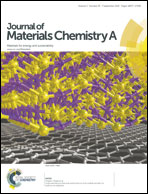Investigation of ultra-thin titania films as hole-blocking contacts for organic photovoltaics†
Abstract
Ultra-thin (0.5–10 nm) plasma-enhanced atomic layer deposited (PE-ALD) titanium oxide (TiOx) films, deposited on indium-tin-oxide (ITO) contacts, are investigated as hole-blocking interlayers using conventional electrochemistry of select probe molecules, in blended heterojunction (P3HT:PCBM) organic photovoltaics (OPVs) and in conventional Al/TiOx/p-Si diode platforms. Even films as thin as 0.5 nm, which represent as few as 10 ALD cycles, begin to show hole blocking in the electrochemical experiments, and optimized rectification and power conversion efficiencies are seen for the diode and OPV platforms respectively at a thickness of ca. 3 nm. These results suggest a significant reactivity of the ALD precursors with the ITO substrate to form conformal films with properties which can normally only be achieved with much thicker TiO2 films created from chemical vapor deposition or sol–gel solution processing. The performance of these PE-ALD TiOx layers is highly dependent on thickness. Up to ca. 3 nm these PE-ALD films remain amorphous, whereas for thicker layers (10 nm) grazing incidence X-ray diffraction shows a transition to the anatase structure, with an increase in both leakage current and reduction in shunt resistance in PV platforms. TiO2 films can be quite attractive electron-selective, hole-blocking interlayers in both PV and photoelectrochemical energy conversion platforms, but need to be thin, owing to their lower intrinsic conductivities. PE-ALD TiO2 films appear to provide these capabilities, with strikingly optimized performance at very low thickness.


 Please wait while we load your content...
Please wait while we load your content...